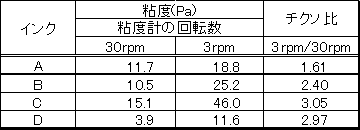~ Thinking about ink characteristics and screen printing from the dining table ~
Screen printing is a great printing method that allows you to print with a wide variety of inks. Screen printing is applied in a wide range of fields, from food to apparel, electronic parts, semiconductors, and solar cells. For this purpose, inks with characteristics suitable for each application are used. So what characteristics affect screen printing?
Let's take an example that is commonly used in our home dining table.
The first is soy sauce, a typical seasoning in Japanese cuisine. Try shaking a soy sauce bottle filled with soy sauce. Soy sauce is shaking in the bottle. Try tilting the jar and pouring soy sauce over the side dish. Soy sauce comes out of the mouth of the bottle.
The first is soy sauce, a typical seasoning in Japanese cuisine. Try shaking a soy sauce bottle filled with soy sauce. Soy sauce is shaking in the bottle. Try tilting the jar and pouring soy sauce over the side dish. Soy sauce comes out of the mouth of the bottle.
The second is honey, which is useful as a health food. Try shaking a jar of honey. Unlike soy sauce, it does not move. Even if you tilt the jar to get the honey out, it won't come out easily. Stick a disposable chopstick into the jar, dip it in honey and pull it out. Stare at the disposable chopsticks that are covered in honey for a while. What happens to the honey? The honey begins to flow slowly and eventually falls off the disposable chopsticks. If honey gets on your clothes, it will be sticky and difficult to wash.
The third is mayonnaise, which is indispensable for salads. Try squeezing a tube of mayonnaise in your hand. It feels thicker than soy sauce. It also feels softer than honey. Squeeze out the mayonnaise on the salad, as usual. And stare at the squeezed mayonnaise. It doesn't flow as quickly as soy sauce. It also does not flow slowly like honey. The shape of the mayonnaise that came out of the tube remains as it is for a while.
These characteristics are also found in screen printing inks. By adjusting this characteristic, various printing is possible. If you want to print thinly and evenly with screen printing, use an ink such as soy sauce or mayonnaise. If you want to print as thin and thick as possible with screen printing, use inks like mayonnaise or honey.
These ink characteristics are expressed by an index called the thixotropic ratio. The thixotropic ratio is obtained by the ratio of the viscosity when the ink is stirred slowly and the viscosity when it is stirred quickly. Liquids like water and soy sauce have a thixotropic ratio of 1. Honey and mayonnaise are greater than 1. The larger this number is, the more advantageous it is for fine line printing.
The table shows the results of examining the actual ink viscosity. Ink makes such a difference. It is also important in screen printing to carefully examine the characteristics of the ink.
The table shows the results of examining the actual ink viscosity. Ink makes such a difference. It is also important in screen printing to carefully examine the characteristics of the ink.

[Table] Ink viscosity and thixotropic ratio
